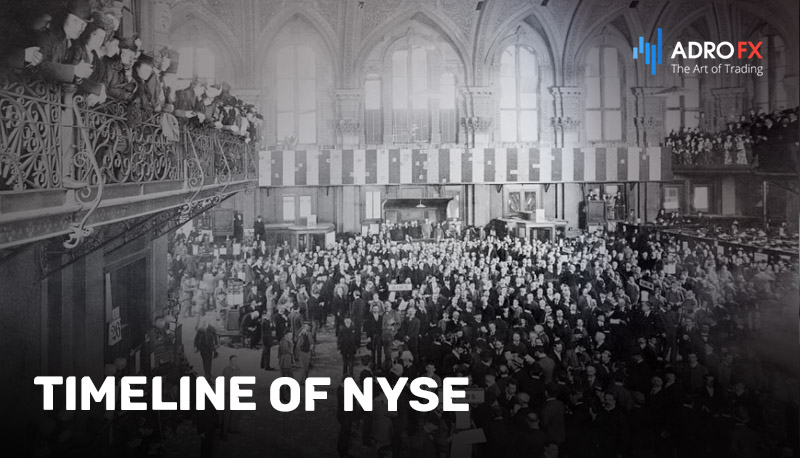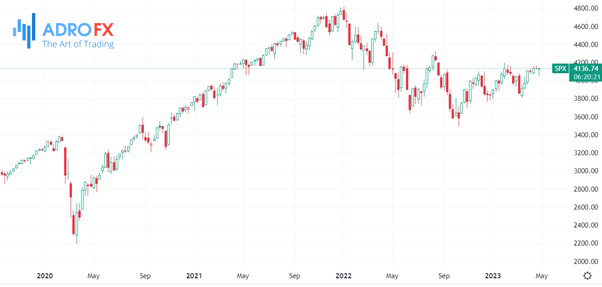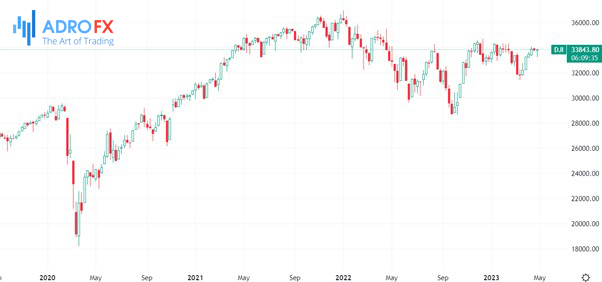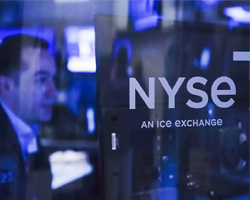New York Stock Exchange (NYSE): Defined & Explained

The New York Stock Exchange (NYSE) appeared 231 years ago, immediately changed the US market, and became the largest marketplace for buying and selling assets in the world.
Nicknamed the BigBoard, it guides all market participants. Global traders monitor the NYSE on a daily basis as it affects subsequent European and Asian exchange operations. The global economic ups and downs of the last 100 years also begin in New York.
In this article, you will find out how the NYSE evolved and why everyone is watching it now.
Origins and Timeline of NYSE
On May 17, 1792, the Buttonwood Agreement was signed - twenty-four brokers officially united and began trading securities and charging a commission for doing so. The agreement was drawn up so that the government and any outsider could not participate in the transactions. Only members of the group were allowed to buy stock directly. Everyone else had to do it through an approved broker. The brokers opened an office in the Tontine Coffee House on the corner of Wall Street and Water Street - where they traded and made deals.
On March 8, 1817, two official organizations, the New York Stock Exchange and the domestic Board of Exchange, appeared. The board drafted a constitution and elected a president - Anthony Stockholm. He opened trading each morning and announced the stock list. At first only five securities were traded on the exchange - shares of the Bank of North America, the First Bank of the United States, and three types of government bonds.
In 1837, Samuel Morse invented the telegraph, and brokers quickly began using the new technology, filling the entire area with wires. Now they could communicate with each other remotely. The telegraph helped them exchange information with each other faster and make decisions about securities.
In 1867, the first stock ticker appeared on Wall Street. Edward A. Calahan of the American Telegraph Company created a special ticker machine. It produced narrow paper strips detailing transactions. The strips were distributed to clerks, who delivered them to typists by pneumatic tube. The typists sent the information to the brokers by telegraph - investors could now get current stock prices anywhere.
On July 3, 1884, the first stock index, the Dow Jones Transportation Average, appeared. It was calculated by Charles Dow, editor of The Wall Street Journal and founder of Dow Jones. The index included nine major US transportation companies.
The first serious blow hit the stock exchange in 1907 because of the decision of the London Bank to sharply lower the discount rate to attract foreign capital. Investors moved en masse to the British capital market. Shares of the New York Stock Exchange lost nearly 40% of their value.
On July 28, 1914, World War I broke out, and the NYSE had to be closed. Many foreign investors began to sell their assets to raise money for the war effort. Because of the active selling, stocks began to plummet in value. The Dow Jones index fell 12%. To stall the decline, the stock exchange halted operations. This was the longest period of closure of the NYSE in history.

On October 24, 1929, "Black Thursday" struck - a panic with the collapse of asset values, followed by the decade-long Great Depression. It became clear that the activities of the stock exchange were of great importance to the country and concerned not only brokers who were thrown out of windows but absolutely all citizens. The era of U.S. prosperity was replaced by a queue for chowder and "Hoovervilles" - buildings made from hand-made materials that could be seen even in the late 1940s.
By 1932, the Dow Jones Index had fallen nearly 10-fold to a low of 41 points.
In order to avoid a repeat of the crash, the Securities and Exchange Commission (SEC) was created in 1934 as a powerful regulator. It approved mandatory registration of exchanges and brokers, full disclosure by listed companies, and no credit purchases of assets allowed. At present, almost 25 percent of Americans own shares in various companies.
Thanks to measures taken, the work of the New York Stock Exchange was interrupted only several times by force majeure (the exchange was closed from the beginning of September to December 1914, but it did not stop working during World War II).
On December 28, 1967, Muriel Siebert became the first female member of the NYSE. She ran a brokerage firm, got her own spot on the trading floor, joined 1,365 men, and began trading on the exchange.
On October 19, 1987, "Black Monday" occurred. Wall Street computers were programmed to sell stocks at certain prices. A domino effect ensued: the computers liquidated thousands of shares, and the clerks could not stop the transactions. The Dow Jones index fell 22.6 percent. This is the biggest drop in a single day.
On September 11, 2001, the World Trade Center terrorist attacks occurred. The NYSE anticipated the panic selling and closed for four days. When the exchange reopened, it had lost $1.5 trillion in value within five days. This is the largest single loss in the history of the market. The Dow Jones Index was down 14 percent and the S&P 500 Index was down 11.6 percent. Airlines were the hardest hit, with American Airlines down 39% in five days and United Airlines down 42%. Gas and oil prices jumped as the market thought oil imports from the Middle East would decline.
On September 15, 2008, Lehman Brothers Bank went bankrupt. This had an immediate negative impact on the stock market, with the Dow Jones falling 5% due to fears of bankruptcy. The NYSE halted all short selling for three weeks and the market continued to decline and remain volatile for a year.
How the NYSE Works
At the NYSE, some of the trades are done by people and some are done by computers. It is one of the last exchanges to use a hybrid model. There are 500 to 1,000 brokers on the NYSE trading floor every day. On the other stock exchanges, paper transactions have become fully automated.

The NYSE is usually open on weekdays and closed on Saturdays and Sundays and observes nine federal holidays every year: it is not open on those days.
How the NYSE Shapes the Dynamics of Other Exchanges
Capitalized at $28 trillion, it is the largest trading floor in the world. The exchange calculates some of the major indices in the world - the S&P 500, the Dow Jones, and the NYSE Composite. They include the most expensive US companies and reflect the dynamics of the entire market. That is why they are called indicators of the country's economy.
When people say "the US market is down," they usually mean the NYSE indices.
For example, if a crisis happens and the stock prices of all major companies drop, it will affect the value of the indices. Analysts and investors look at the S&P 500 or Dow Jones, understand what is happening in the market, and make investment forecasts.
Because of the time zone difference, the US indices are calculated first, so the NYSE not only shows the state of the US economy but also affects all the major stock markets of the planet. For example, if the Dow Jones falls, it will affect the indices of other countries.
NYSE vs Nasdaq: What's the Difference?
The Nasdaq, founded in 1971, is the second-largest stock exchange in the United States after the NYSE, with a market capitalization of $19 trillion, $5.5 trillion less than the NYSE. Despite their similarities, there are several key differences between the two exchanges.
The NYSE used to operate both an electronic trading system and an in-house trading system staffed by live specialists before the pandemic. In contrast, Nasdaq has been fully electronic since its inception.
The NYSE uses an auction market to set prices, with buyers and sellers bidding competitively at the same time, resulting in transactions when the buyer's bid and the seller's offer match. In comparison, the Nasdaq dealer market model sets all prices through dealers who continuously update bid (sell) and ask (buy) prices throughout the trading day.
Listing fees vary significantly between the two exchanges. Nasdaq's Capital Market's lowest level has listing fees ranging from $55,000 to $80,000, while NYSE's minimum listing fee is $150,000.
Investors typically consider NYSE as an exchange for older, more established companies, while the Nasdaq focuses on newer companies, particularly those in technology and innovation, making a Nasdaq listing potentially riskier for some investors.
NYSE Indices
There are many groups of indices on the New York Stock Exchange, including those beginning with the NYSE - surprisingly, given the huge capitalization of the New York Stock Exchange, most of the indices are not popular. However, there are interesting but little-known variants - for example the index of brokers NYSE Arca Securities Broker/Dealer Index (XBD), composed of the largest investment and brokerage companies (Charles Schwab, Goldman Sachs, E*TRADE Group, etc.).
NYSE Composite
The best-known index in this series is the NYSE Composite, consisting of more than 3,700 stocks (at the moment). It contains all companies present on the exchange.

It is clear that most of the companies constituting the index are American, and the index value measured in dollars is in fact the average value of all shares on the NYSE. Accordingly, if we multiply the index value by the number of all shares, we will receive the market capitalization of the stock exchange.
S&P 500
The S&P 500 Index (Standard and Poor's) includes the 500 richest companies and comprehensively evaluates the US economy.

It is the most important US index. It includes stocks of 400 industrial, 20 transportation, 40 financial-economic, and 40 utility companies. The 1941 base value is 10 p., in 2023it is within 4,100 points.
Dow Jones Index
The Dow Jones Index is the oldest existing US market index. It was created by Charles Dow, to track the development of American stock markets. The index was first published on May 26, 1896. Originally, the index was calculated as an arithmetic average of the stock prices of the 12 largest companies. Now a scaled average is used to calculate the index in order to maintain comparability with changes in the internal structure of its constituent stocks.

At present, the Dow Jones index covers the 30 largest US companies. It is the simplest and most commonly used indicator of the US economy. The list of companies covered by the Dow Jones index is revised with the development of the stock market. The editors of The Wall Street Journal compile the list.
Conclusion
The NYSE is the largest stock exchange in the world, by a notable margin from second place. More than a quarter of the world's stock market capitalization is concentrated here. Because of its high liquidity, many traders prefer to trade on the NYSE, but for investors, the exchange is attractive due to its concentration of many low-cost exchange-traded funds with low spreads. It is this exchange and its assets that have the most reliable long-term data - you can find calculations on the behavior of US stock and bond prices since 1800, while for many other markets, this range is no longer than half a century.

About AdroFx
Established in 2018, AdroFx is known for its high technology and its ability to deliver high-quality brokerage services in more than 200 countries around the world. AdroFx makes every effort to keep its customers satisfied and to meet all the trading needs of any trader. With the five types of trading accounts, we have all it takes to fit any traders` needs and styles. The company provides access to 115+ trading instruments, including currencies, metals, stocks, and cryptocurrencies, which make it possible to make the most out of trading on the financial markets. Considering all the above, AdroFx is the perfect variant for anyone who doesn't settle for less than the best.









